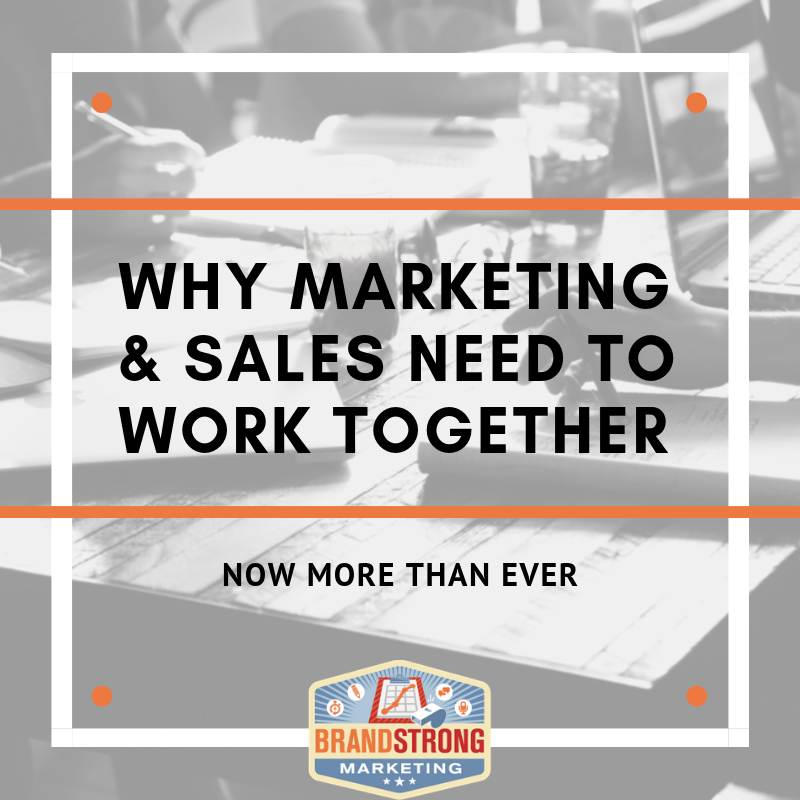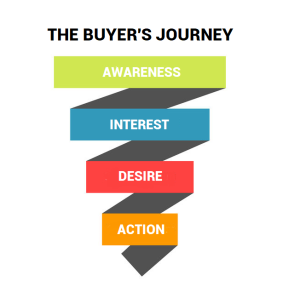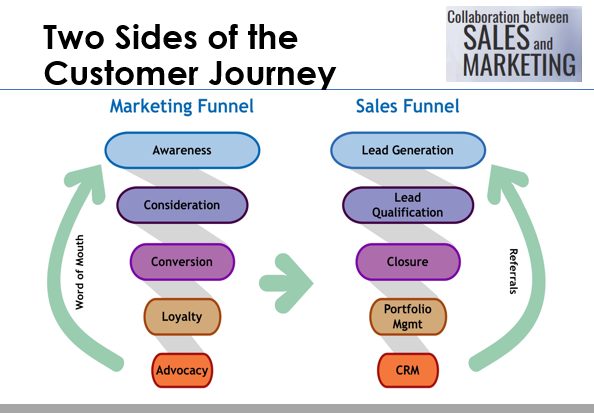Sales and Marketing: Why Working Together is More Important Than Ever
 In our last post we discussed the difference between the sales and marketing functions in your business. To recap, your marketing activities attract attention and get you a conversation with a prospect while your sales activities work to close the deal, turning prospects into clients. As traditionally defined, sales and marketing are unique functions in your business with their own objectives and the process seems to be linear. Attract attention, get a conversation (lead), and hand off the prospect to sales to work to close the deal. However, things changed.
In our last post we discussed the difference between the sales and marketing functions in your business. To recap, your marketing activities attract attention and get you a conversation with a prospect while your sales activities work to close the deal, turning prospects into clients. As traditionally defined, sales and marketing are unique functions in your business with their own objectives and the process seems to be linear. Attract attention, get a conversation (lead), and hand off the prospect to sales to work to close the deal. However, things changed.
In today’s marketplace, this handoff from one activity to another is not so clear and linear. It’s fuzzy, it’s circular. And, the handoff point for each prospect is different. Because of that, what traditionally was a sales activity may no longer be. Whether you have a marketing and sales team at your company, or you are a small business owner or solopreneur where you or another person handles all of the marketing and sales functions, you need to sync your marketing and sales activities because the way people buy has changed.
What happened?
Power to the People
Just when you thought you had a handle on how marketing and sales can help you grow your business, technology disrupted the status quo. The traditional marketing/sales model we all learned in school and followed for many years changed because of the Internet. The Internet put information into buyers’ hands and now how buyers and sellers interact is different.

When a potential buyer needs something, they go on a journey. There are a variety of models to explain a buyer’s journey, but I like the AIDA model, because it is simple and has stickiness – easy to remember, easy to understand. The model calls out four different stages in the journey; at the mouth of the funnel you have Awareness, then your prospects move down through the funnel to Interest, Desire, and Action.
Both marketing and sales play an important role to usher the prospect through this journey to a successful end – a sale. Marketing traditionally played a big role at top of this AIDA funnel. Marketing’s job was build awareness and start to generate interest. Then sales took over for the rest of the journey.
But this linear, sequential model is no longer effective. Let’s see how it changed.
For example, 15-20 years ago here’s how that B2B process worked.
Joe has a problem. He notices your ad in an industry magazine or on TV or the radio that mentions a solution to his problem. Your ad says to call for more information. He does. Your marketing has done its job. It attracted his attention and got him to call for a conversation getting him 20-30% of the way into the buyer’s journey.
Karen, your salesperson, now takes over giving Joe more information about your solution, in person or on the phone. If asked, she provides Joe with information on how your solutions compare to competitive offerings and maybe gives him the name of a few customers to call for references or endorsements. Hopefully she is building rapport with Joe, so he trusts her and wants to do business with your company because he likes her professional manner. She provides him with a quote or proposal and then closes the deal.
However, here’s how the same situation would play out today.
Joe has a problem. He decides to do research on the Internet to see if there is a solution to his problem. He goes into one of his LinkedIn groups and asks his peers if they recommend any solutions to his problem. Someone recommends your company. He goes to your website and reads everything he can to understand how this solution will best solve his problem. He then looks at competitive offerings online. He reads any review he can find on your solution to see if others recommend it or have had problems. He sees that someone recommends a totally different approach. He then starts over gathering research on this new approach. He decides that your solution is still the right solution for him and his company and is now ready to talk.
He calls and talks with Karen. She provides him with a proposal, answers any final questions he may have, and tries to build a relationship with Joe quickly to earn his trust to close the sale. She does, (way to go, Karen!), but Joe was 70-75% of the way through the funnel before ever talking to anyone from your company.
The Lines Are Fuzzy or Non-Existent
So, where your salesperson used to be the one to provide more in-depth information, meet with the prospect to ask questions, understand their challenge, and create a relationship building enough trust to be considered for the sale, prospects today are doing this themselves.
And, if you offer the option to purchase online, they may never talk to anyone at your company at all.
With the power of information on websites, social media, blogs, and videos on YouTube, customers can help themselves to a wealth of information about your product or service, your competitors’ offerings, and reviews. Before they call you, they will know who you are, what services you offer, and what your reputation is. They may have also engaged with your company online to build a virtual relationship.
This is a huge shift in the way people buy. Companies need to look at the roles for sales and marketing activities in this new DIY buyer’s journey.
For example, your marketing has to do more work to inform, convince, anticipate and answer questions, as well as build trust. This changed process makes it even more important than ever that sales and marketing work together because sales needs marketing to qualify and educate the prospect now.
And marketing needs sales to educate them on the potential client – their challenges, needs, purchasing habits, objections, FAQs – to create the most effective marketing.
Here’s where the in sync part comes in. The consistency of your messaging from marketing to sales is so important because you don’t know where the customer is coming into the sales funnel.
The New Buyer’s Journey
Take a look at this more detailed graphic.

I like this model better because it shows that BOTH marketing and sales have activities to support the buyer throughout his or her journey and are ready when and where the customer starts. The prospect may start their journey on the marketing side and jump back and forth throughout their journey ending on the sales side. Knowing that, marketing and sales need to have their messaging in sync. They can’t contradict each other and they need to share information to effectively close the sale.
When your sales and marketing disciples work together, you see great results:
- First, sales and marketing provide information to each other and provide natural checks and balances. You’ll be able to create irresistible messaging, targeted marketing campaigns, SEO worth content, and sales tools faster.
- Second, the sharing of information makes both jobs easier and therefore more effective. Two heads, each with great information on the buyer, are better than one. You’re a team, work together!
- Third, your customer will be more educated when they are ready to buy, because you published the content the buyer needed to get to the point where they are ready to pull the trigger, which allows them to journey through your sales funnel quicker.
When you add all these benefits up, you will see your company add more leads and close more sales.
So, if this model is more DIY, marketing has to play a much bigger role in ushering the buyer along in his or her journey. In our next post, we’ll share what type of marketing/sales content is needed at each stage of the buyer’s journey to help you be more effective and successful with this new DIY model.
You Might Be Interested:






